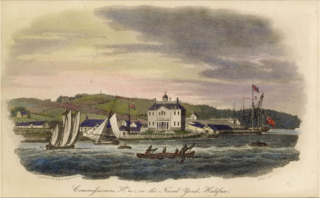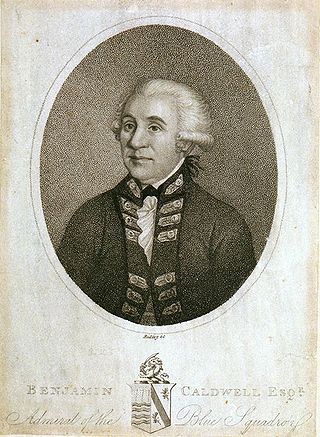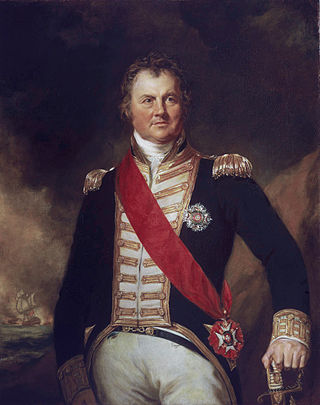
Admiral of the Fleet Richard Howe, 1st Earl Howe, was an English Royal Navy officer, politician and peer. After serving throughout the War of the Austrian Succession, he gained a reputation for his role in amphibious operations against the French coast as part of Britain's policy of naval descents during the Seven Years' War. He also took part, as a naval captain, in the decisive British naval victory at the Battle of Quiberon Bay in November 1759.

Admiral Adam Duncan, 1st Viscount Duncan was a British admiral who defeated the Dutch fleet off Camperdown on 11 October 1797. This victory is considered one of the most significant actions in naval history.

Vice-Admiral Sir John Lockhart-Ross, 6th Baronet, known as John Lockhart from 1721 to 1760, was an officer of the Royal Navy who saw service during the War of the Austrian Succession, Seven Years' War, and the American War of Independence, and served for a time as a Member of Parliament.

Admiral Sir Richard Hussey Bickerton, 2nd Baronet, KCB, was a British naval officer. He was born in Southampton, the son of Vice-admiral Sir Richard Bickerton and first served aboard HMS Medway in June 1774, in the Mediterranean. His first command came in March 1779 when he was given HM Sloop Swallow as a reward for his part in an engagement with a much larger opponent. Bickerton later joined Rodney's squadron in the West Indies where he took part in the capture of Sint Eustatius in 1781. Making post captain on 8 February 1781, he took temporary command of HMS Invincible and fought in her at the Battle of Fort Royal on 29 April 1781.

HMS Pegasus was a 28-gun Enterprise-class sixth rate. This frigate was launched in 1779 at Deptford and sold in 1816. Pegasus had a relatively uneventful career and is perhaps best known for the fact that her captain from 1786 to 1789 was Prince William Henry, the future King William IV. By 1811 Pegasus was a receiving ship at Chatham; she was sold in 1816.

Royal Naval Dockyard, Halifax was a Royal Navy base in Halifax, Nova Scotia. Established in 1759, the Halifax Yard served as the headquarters for the Royal Navy's North American Station for sixty years, starting with the Seven Years' War. The Royal Navy continued to operate the station until it was closed in 1905. The station was sold to Canada in 1907 becoming His Majesty's Canadian Dockyard, a function it still serves today as part of CFB Halifax.

Vice Admiral Sir George Collier was an officer of the Royal Navy who saw service during the Seven Years' War, the American War of Independence and the French Revolutionary Wars. As commander of the fourth-rate ship HMS Rainbow, he was one of the most successful British naval commanders during the opening stages of war with America. He achieved considerable success as one of the senior officers on the North American coast, conducting and organizing several highly effective raids and counter-strikes. He was superseded however, and returned to Britain to play a role in the closing events of the war in European waters, before moving ashore to start a political career. He enjoyed a brief return to service with the resumption of war with France, and achieved flag rank, but died shortly afterwards.
Admiral Sir Richard Hughes, 2nd Baronet was a Royal Navy officer.

Admiral Sir Richard Onslow, 1st Baronet was an English naval officer who played a distinguished role in the 1797 Battle of Camperdown.

Admiral Sir Benjamin Caldwell, was a senior and experienced British Royal Navy officer of the eighteenth century. His many victories and achievements were overshadowed by his acrimonious departure from the Navy during the French Revolutionary Wars after highly publicised disputes with Admiral Lord Howe and Admiral Sir John Jervis, over perceived slights against his name following the battle of the Glorious First of June in 1794. As a result of these disputes, Caldwell was overlooked for future employment and only received recognition for his service from King George IV months before his death.

Vice-Admiral Lord Hugh Seymour was a senior British Royal Navy officer of the late 18th century who was the fifth son of Francis Seymour-Conway, 1st Marquess of Hertford, and became known for being both a prominent society figure and a highly competent naval officer. He served during the American Revolutionary and French Revolutionary Wars and later in his career performed a period of shore duty on the Admiralty board.

Admiral Sir Edward Thornbrough, GCB was a senior, long-serving veteran officer of the British Royal Navy during the late eighteenth and early nineteenth century. He saw action in the American Revolutionary War, the French Revolutionary Wars and the Napoleonic Wars, being wounded several times and once captured by American forces after a shipwreck. During the wreck, his conduct towards American prisoners aboard his ship was considered so exemplary that the American authorities later released him without parole or exchange.

HMS Mercury was a 28-gun Enterprise-class sixth-rate frigate of the Royal Navy. She was built during the American War of Independence and serving during the later years of that conflict. She continued to serve during the years of peace and had an active career during the French Revolutionary Wars and most of the Napoleonic Wars, until being broken up in 1814.

Sir Charles Henry Knowles, 2nd Baronet, GCB was an officer of the Royal Navy, who saw service during the American War of Independence, and the French Revolutionary and Napoleonic Wars, eventually rising to the rank of Admiral. He was an extraordinary figure and a great tactical innovator. Highly intellectual, he authored a number of signal books and had the chance to put his ideas into practice during his naval career. Knowles was at times beset by problems with discipline aboard his ships, often due to large proportions of raw recruits and untrained seamen. This may have been a factor in his rocky relationship with his superior, Sir John Jervis, which eventually led to Knowles's retirement from active service after the Battle of Cape St Vincent, and his concentration on scholarly studies of the issues affecting the naval service.
HMS Eurydice was a 24-gun Porcupine-class post ship of the Royal Navy built in 1781 and broken up in 1834. During her long career she saw service in the American War of Independence, the French Revolutionary Wars and the Napoleonic Wars. She captured a number of enemy privateers and served in the East and West Indies, the Mediterranean and British and American waters.

Admiral Sir John Knight, KCB was a senior British Royal Navy officer during the late eighteenth and nineteenth centuries most noted for his activities as a post captain during the American and French Revolutionary Wars. Serving with the Caribbean Fleet during the American war, Knight fought several significant battles and was commended for his service and made tutor of the young Prince William. During the French wars he served with the North Sea fleet under Admiral Adam Duncan and was engaged at the Battle of Camperdown against the Dutch. During the Napoleonic Wars that followed he held a senior administrative role at Gibraltar and retired in 1815 to his home and eight children. Although Knight was respected professionally, he was not popular with his men and fellow officers and was criticised for his ability to maintain discipline and for his close relationship with his family which some suggested had a negative impact on his performance as an officer.
James Coutts Crawford was an officer in the Royal Navy who served during the American War of Independence and the French Revolutionary and Napoleonic Wars.
Admiral George Wilson was an officer in the Royal Navy who saw service in the American Revolutionary War and the French Revolutionary War. The son of a Chief Justice of Dominica, he joined the navy as a follower of Sir John Jervis on board the ship of the line HMS Foudroyant. In January 1780 he served on Vice-Admiral Richard Howe's flagship HMS Victory at the relief of Gibraltar, after which he was promoted to post-captain. While in command of the post ship HMS Eurydice he participated in the Battle of Saint Kitts and Battle of the Saintes in 1782 before he was appointed to the ship of the line HMS Fame. Wilson was given command of the frigate HMS Inconstant during the Spanish Armament and then at the beginning of the French Revolutionary War, the ship of the line HMS Bellona. In Bellona he served extensively on the Leeward Islands Station, taking a 44-gun frigate in January 1795. He was then present at the Capitulation of Saldanha Bay in 1796 and the invasions of Trinidad and Porto Rico in 1797. In 1799 Wilson was promoted to rear-admiral and rose through the ranks by seniority to become an admiral of the red in 1819, however he never served at sea as an admiral. He died at his seat Redgrave Hall in Suffolk on 6 March 1826 at the age of seventy.














